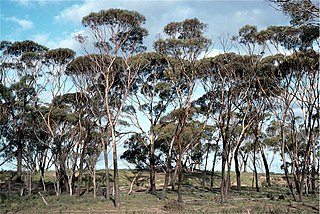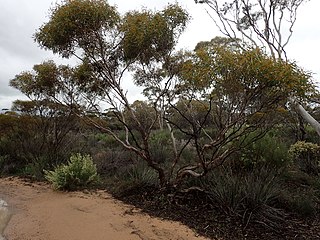
Eucalyptus accedens, commonly known as smooth bark wandoo or powderbark wandoo is a species of tree endemic to the south-west of Western Australia. Although the common names suggest it is similar to wandoo,, the two species are very different botanically. The bark of E. accedens has talc-like powder, at least on the protected side of the trunk and the tree usually grows on laterite in higher places.

Eucalyptus eremophila, commonly known as the sand mallet or tall sand mallee, is a species of mallet that is endemic to semi-arid regions of Western Australia. It has smooth pale brown and greyish bark, narrow lance-shaped to elliptical adult leaves, flower buds arranged in groups of between seven and eleven with an elongated operculum, and cup-shaped to barrel-shaped fruit.

Eucalyptus populnea, commonly known as poplar box, bimble box or bimbil box, is a species of small to medium-sized tree that is endemic to eastern Australia. It has rough, fibrous or flaky bark on the trunk and branches, egg-shaped, elliptical or more or less round leaves, flower buds arranged in groups of seven to fifteen or more, white flowers and conical, hemispherical or cup-shaped fruit.

The pied honeyeater is a species of bird in the family of honeyeaters Meliphagidae and the sole species in the genus Certhionyx. This species is also known as the black and white honeyeater or western pied honeyeater.

Eucalyptus oleosa, commonly known as the red mallee, glossy-leaved red mallee, acorn mallee, oil mallee or giant mallee, is a tree or mallee that is native to Australia. The leaves were once harvested for the production of cineole based eucalyptus oil. Eucalyptus cneorifolia is now the predominant strain used in production due to a higher oil content in new growth.

Eucalyptus salmonophloia, commonly known as salmon gum, wurak or weerluk or woonert or marrlinja. is a species of small to medium-sized tree that is endemic to Western Australia. It has smooth bark, narrow lance-shaped to curved adult leaves, flower buds in groups of between nine and thirteen, creamy white flowers and hemispherical fruit.

Eucalyptus wandoo, commonly known as wandoo, dooto, warrnt or wornt and sometimes as white gum is a small to medium-sized tree that is endemic to the southwest of Western Australia. It has smooth bark, lance-shaped adult leaves, flower buds in groups of nine to seventeen, white flowers and conical to cylindrical fruit. It is one of a number of similar Eucalyptus species known as wandoo.

Eucalyptus albens, known as the white box, is a common tree of the western slopes and plains of New South Wales and adjacent areas in Queensland and Victoria. It has rough, fibrous bark on the base of its trunk and smooth, white bark above. The leaves are lance-shaped and groups of seven spindle-shaped flower buds are arranged in leaf axils or on the ends of the branches. White flowers are mostly present between August and February and the fruit are barrel-shaped to urn-shaped.

Eucalyptus socialis, commonly known as the red mallee, or grey mallee, is a species of mallee that is endemic to inland Australia.

Eucalyptus astringens, commonly known as brown mallet or to Noongar people as mallat, woonert or wurnert, is a tree that is endemic to the South West region of Western Australia. It has smooth, shiny bark on its trunk and branches, lance-shaped leaves, pendulous flower buds arranged in groups of seven, cream-coloured to pale lemon-coloured flowers and cup-shaped to bell-shaped or conical fruit. This tree has also been introduced to Victoria.

Eucalyptus incrassata, commonly known as the lerp mallee, yellow mallee, ridge fruited mallee or rib fruited mallee, is a species of mallee that is endemic to southern Australia. It has smooth bark, sometimes with rough, ribbony bark near the base, lance-shaped adult leaves, flower buds in groups of seven, creamy white, pale yellow, sometimes pink or red flowers, and cylindrical, barrel-shaped or bell-shaped fruit.

Eucalyptus kondininensis, commonly known as Kondinin blackbutt, is a species of tree that is endemic to Western Australia. It has rough, black bark on the trunk, smooth grey to white bark on the branches, lance-shaped adult leaves, flower buds in groups of seven, white flowers and cup-shaped to conical fruit.

Eucalyptus longicornis, commonly known as red morrel, morryl, poot or pu, is a species of large tree that is endemic to the south-west of Western Australia. It has rough, fibrous, fissured bark on the trunk, smooth greyish bark above, flower buds in groups of seven or more, white flowers and shortened spherical fruit.

Eucalyptus myriadena, also known as blackbutt, is a species of mallee or tree that is native to Western Australia. It has rough, coarse flaky bark on part of the trunk, smooth bark above, linear to narrow lance-shaped adult leaves, flower buds in groups of between nine and thirteen, white flowers and narrow cylindrical to barrel-shaped fruit. It is widely distributed in the wheatbelt and goldfield areas of the state.

Eucalyptus occidentalis, commonly known as the flat topped yate or the swamp yate, is a tree that is native to Western Australia. The Noongar names for the tree are Mo or Yundill.

Eucalyptus odontocarpa, commonly known as Sturt Creek mallee, is a mallee that is native to northern Australia. Indigenous Australians know the plant as Warilyu.

Eucalyptus yilgarnensis, commonly known as yorrell or yorrel, is a species of mallee, rarely a small tree, that is endemic to Western Australia. It usually has rough bark on the trunk, smooth bark above, linear to narrow elliptical or narrow lance-shaped adult leaves, flower buds in groups of seven or nine, white flowers and barrel-shaped fruit.

Corymbia foelscheana, commonly known as the broad-leaved bloodwood, fan-leaved bloodwood or smooth-barked bloodwood, is a species of small tree that is endemic to northern Australia. It has thin, rough, tessellated bark on some or all of the trunk, smooth bark above, broadly egg-shaped to broadly lance- shaped adult leaves, flower buds usually in groups of seven, creamy white flowers and urn-shaped fruit.

Eucalyptus dundasii, commonly known as the Dundas blackbutt, is a species of tree that is endemic to Western Australia. It has rough, scaly bark on the lower part of the trunk, smooth bark above, narrow lance-shaped to curved adult leaves, flower buds in groups of seven, creamy white flowers and cylindrical to narrow urn-shaped flowers.
Eucalyptus moderata, also known as redwood mallee, is a species of tree or a mallee that is endemic to the southwest of Western Australia. It has rough, hard, fibrous bark on some or all of the trunk, lance-shaped adult leaves, flower buds usually in groups of seven, pale yellow flowers and pendulous, urn-shaped fruit.





















